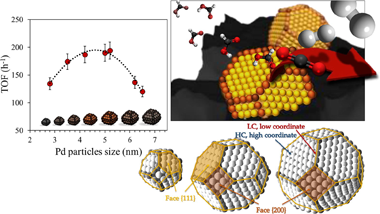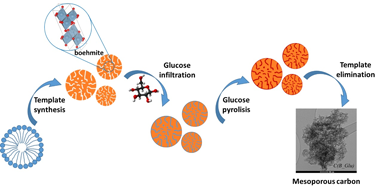Scientific Papers in SCI
2021
2021
Química de Superficies y Catálisis
Structure-sensitivity of formic acid dehydrogenation reaction over additive-free Pd NPs supported on activated carbon
Santos, J.L.; Megías-Sayago, C.; Ivanova, S.; Centeno, M.A.; Odriozola, J.A.Chemical Engineering Journal, 420 (2021) 127641
Show abstract ▽

In this study the size-activity dependence of palladium based catalysts in formic acid dehydrogenation reaction was investigated and evaluated. A wide range of particle sizes was considered and the catalyst series were prepared upon variation of some synthetic parameters, precursor and solvent nature in particular. Synthesis method variations affect significantly Pd particle size and results in diverse activity toward hydrogen production. An optimal size was observed and explained by the diverse proportion of low and high coordinated Pd states available for different samples within the series. The evaluation of particles much bigger than 6 nm changes importantly the fraction of high and low coordination atoms and allows the clear confirmation of the importance of the presence of low coordination atoms on the surface of catalyst.
September, 2021 | DOI: 10.1016/j.cej.2020.127641
Química de Superficies y Catálisis
Mesoporous Carbon Production by Nanocasting Technique Using Boehmite as a Template
Ortega-Franqueza, M; Ivanova, S; Dominguez, MI; Centeno, MACatalysts, 11 (2021) 1132
Show abstract ▽

A series of mesoporous carbonaceous materials were synthesized by the nanocasting technique using boehmite as a template and glucose as a carbon precursor. After pyrolysis and template removal, the resulting material is a mesoporous carbon that can be additionally doped with N, B and K during prepyrolysis impregnation. In addition, the influence of doping on the morphology, crystallinity and stability of the synthesized carbons was studied using X-ray diffraction, nitrogen physisorption, thermogravimetry, Raman and IR spectroscopy and transmission electron microscopy. While the nanocasting process is effective for the formation of mesopores, KOH and urea do not modify the textural properties of carbon. The use of H3PO4 as a dopant, however, led to the formation of an AlPO4 compound and resulted in a solid with a lower specific surface area and higher microporosity. All doped solids present higher thermal stability as a positive effect of the introduction of heteroatoms to the carbon skeleton. The phosphorus-doped sample has better oxidation resistance, with a combustion temperature 120-150 degrees C higher than those observed for the other materials.
September, 2021 | DOI: 10.3390/catal11091132
Tribología y Protección de Superficies
Effect of Al content on the hardness and thermal stability study of AlTiN and AlTiBN coatings deposited by HiPIMS
Mendez, A; Monclus, MA; Santiago, JA; Fernandez-Martinez, I; Rojas, TC; Garcia-Molleja, J; Avella, M; Dams, N; Panizo-Laiz, M; Molina-Aldareguia, JMSurface & Coatings Technology, 422 (2021) 127513
Show abstract ▽
The microstructure, mechanical properties and thermal stability of AT(x)Ti(1-x)N and Al1Ti1-xBN coatings grown by reactive high-power impulse magnetron sputtering (HiPIMS) have been analyzed as a function of Al/(Al + Ti) ratio (x) between 0.5 and 0.8. The coatings were predominantly formed by a face-centered cubic Ti(Al)N crystalline phase, both with and without B, even for x ratios as high as 0.6, which is higher than the ratio typically encountered for AlxTi1-xN coatings deposited by reactive magnetron sputtering. B doping, in combination with the highly energetic deposition conditions offered by HiPIMS, results in the suppression of the columnar grain morphology typically encountered in AlxTi1-xN coatings. On the contrary, the AlxTi1-xN coatings grown by HiPIMS present a dense nanocomposite type microstructure, formed by nanocrystalline Ti(Al) N domains and amorphous regions composed of Ti(Al)B 2 and BN. As a result, high-Al content (x approximate to 0.6) AlxTi1-xN coatings grown by HiPIMS offer higher hardness, elasticity and fracture toughness than AlxTi1-xN coatings. Moreover, the thermal stability and the hot hardness are substantially enhanced, delaying the onset of formation of the detrimental hexagonal AlN phase from 850 degrees C in the case of Al0.6Ti0.4N, to 1000 degrees C in the case of Al0.6Ti0.4N.
September, 2021 | DOI: 10.1016/j.surfcoat.2021.127513
Fotocatálisis Heterogénea: Aplicaciones
Photocatalytic production of hydrogen and methane from glycerol reforming over Pt/TiO2–Nb2O5
Iervolino, G; Vaiano, V; Murcia, JJ; Lara, AE; Hernández, JS; Rojas, H; Navío, JA; Hidalgo, MCInternational Journal of Hydrogen Energy
Show abstract ▽
In this study, platinized mixed oxides (TiO2–Nb2O5) were tested on photocatalytic hydrogen production from a glycerol solution under UV light. Different samples with different Ti:Nb ratios were prepared by using a simple method that simultaneously combined a physical mixture and a platinum photochemical reduction. This method led to improved physicochemical properties such as low band gap, better Pt nanoparticle distribution on the surface, and the formation of different Pt species. Niobia content was also found to be an important factor in determining the overall efficiency of the Pt–TiO2–Nb2O5 photocatalyst in the glycerol reforming reaction. The photocatalytic results showed that Pt on TiO2–Nb2O5 enhanced hydrogen production from the aqueous glycerol solution at a 5 wt% initial glycerol concentration. The influence of different operating conditions such as the catalyst dosage and initial glycerol concentration was also evaluated. The results indicated that the best hydrogen and methane production was equal to 6657 μmol/L and 194 μmol/L, respectively after 4 h of UV radiation using Pt/Ti:Nb (1:2) sample and with 3 g/L of catalyst dosage. Moreover, the role of water in photocatalytic hydrogen production was studied through photocatalytic activity tests in the presence of D2O. The obtained results confirmed the role of water molecules on the photocatalytic production of hydrogen in an aqueous glycerol solution.
September, 2021 | DOI: 10.1016/j.ijhydene.2021.09.111
Reactividad de Sólidos
Mechanochemical synthesis of ternary chalcogenide chalcostibite CuSbS2 and its characterization
Dutkova, E; Sayagues, MJ; Fabian, M; Kovac, J; Kovat, J; Balaz, M; Stahorsky, MJournal of Materials Science-Materials in Electronics (2021)
Show abstract ▽
In this work, the very rapid one-step mechanochemical synthesis of nanocrystalline ternary chalcogenide chalcostibite CuSbS2 prepared from copper, antimony, and sulfur precursors by high-energy milling for only 30 min in a planetary mill is reported. XRD confirmed the orthorhombic crystal structure of CuSbS2. The crystallite size of CuSbS2 calculated by LeBail refinement of the X-ray powder diffraction data was 25 nm. The nanocrystalline chalcostibite CuSbS2 was also confirmed by transmission electron microscopy. The purity of CuSbS2 was verified by Raman spectroscopy. The synthesized chalcostibite exhibits the specific surface area value of 2.4 m(2)g(-1). UV-Vis spectroscopy showed the optical bandgap of CuSbS2 as 1.54 eV with wide range of absorption in visible region. Photoresponse of CuSbS2 was confirmed by I-V measurements under dark and light illumination. The proposed mechanochemical synthesis provides an alternative approach to prepare also other ternary semiconductor nanomaterials. CuSbS2 semiconductor nanocrystals have the potential to be used as light absorbers in photovoltaics.
August, 2021 | DOI: 10.1007/s10854-021-06767-9
- ‹ previous
- 69 of 410
- next ›














